Édouard Manet
Appearance
(Redirected from Manet)
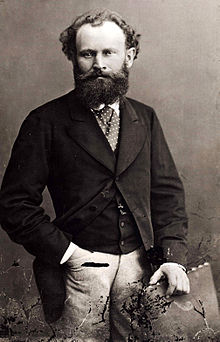
Édouard Manet (23 January 1832 – 30 April 1883) was a French painter - one of the first nineteenth century artists to approach modern-life subjects. His art bridged the divide between Realism and Impressionism.


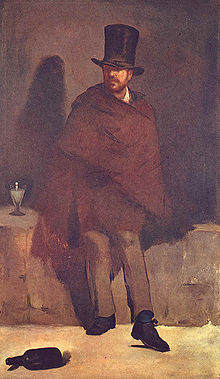






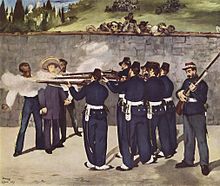

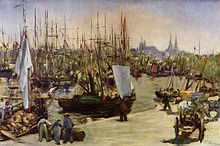







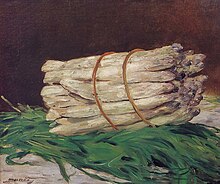
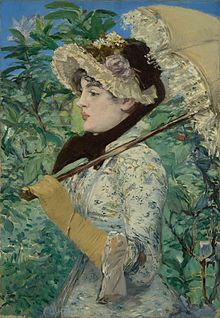
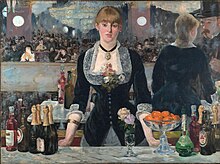

Quotes
[edit]1850s
[edit]- I don't know why I'm here. Everything before our eyes is ridiculous. The light is wrong, the shadows are wrong. When I enter in the studio I feel like I am entering a tomb [in the studio of their common art-teacher Thoman Couture ]. I know we can't make a model undress in the street. But there are fields, and at least in the summer we could do studies of the nude in the country, since the nude appears to be the first and the last word in art.
- Manet's early quote in 1850, spoken to his friend Antonin Proust; as quoted in Manet, Nathalia Brodskaya, Parkstone International, 2011, ISBN 978-1-78042-029-5, p. 12
1860s
[edit]- So, they'd prefer me to do a nude, would they? Fine I'll do them a nude.. .I'll redo it [his painted copy of Giorgioni's 'Woman with musicians'], with a transparent atmosphere, like those women over there [women bathing in the river, Summer of 1862]. Then I suppose they'll really tear me to pieces. They'll tell me I'm just copying the Italians now, rather than the Spanish. Ah, well, they can say what they like. [the painting Manet means here became his most famous one: 'Déjeuner sur l'herbe'].
- Manet's quote to his friend Antonin Proust in 1862, from Manet, Francoise Cachin, Barrie & Jenkins, London 1991, p. 16
- How I miss you here [his friend in Paris - Manet visited Madrid and the famous museums there], and how delighted you would have been to see Velázquez, who in himself alone is worth the journey.. .He is the painter of painters. He did not astonish me, but delighted me.
- Quote from Manet's letter to Fantin-Latour, Madrid 1865, as quoted in Letters of the great artists – from Blake to Pollock -, Richard Friedenthal, Thames and Hudson, London, 1963, (translation Daphne Woodward), p. 118
- Who is this Monet whose name sounds just like mine and who is taking advantage of my notoriety?
- Quote 1865, recorded by Theodore Duret at the [[w:Salon (Paris)|Paris Salon that year; as quoted on: SCRIBD - 'Manet's letters'
- I should be going with Champfleury and Stevens, but they keep putting it off. Anyway, they are bloody bores. Excuse the unseeming language, but since my letter is not for publication, I can say what I please. Touché.
- Quote in a letter, 23 August 1865, to his friend Zacharie Astruc; as quoted in Manet by Himself, Correspondence & Conversation; Paintings, pastels, prints and drawings, ed. Juliette Bareau-Wilson; Macdonald (1991)
- My dear Zola, - I am making up my mind to hold a private show. I have at least two score pictures to exhibit. I've already already been offered a site in a very good location near the Champ de Mars. I am going to stake the lot and seconded by men like yourself, am hopeful of success. See you soon. Cordially, yours ever, All of us here are delighted with your article, and I am instructed to send you thanks.
- Quote of Manet's letter to Zola, Wednesday, 2 January 1867; as quoted on: SCRIBD - 'Manet's letters'
- Get it down quickly, don't worry about the background. Just go for the tonal values. You see? When you look at it, and above all when you see how to render it as you see it, thats is, in such a way that its make the same impression on the viewer as it does on you, you don't look for, you don't see the lines on the paper over there, do you? And then, when you look at the whole thing you don't try to count the scales on the salmon, of course you don't. You see them as little silver pearls against grey and pink – isn't thats right? – look at the pink of the salmon, with the bone appearing white in the centre and then grays, like the shades of mother of pearl. And the grapes, now do you count each? No, of course not. What strikes you is their clear, amber colour and the bloom which models the form by softening it. What you have to decide with the cloth is where the highlights come and then the planes which are not in the direct light. Halftones are for the magasin pittoresque engravers. The folds will come by themselves if you put them in the proper place. Ah! M. Ingres, there's the man! We're all just children. There's the one who knew how to paint materials! Ask Bracquemond [Paris' artist and print-maker]. Above all, keep your colours fresh. [instructing his new protegee, the Spanish young woman-painter Eva Gonzales, circa 1869]
- Manet, recorded by Philippe Burty, as cited in Manet by Himself, ed. Juliet Wilson-Bareau, Little Brown 2000, London; p. 52
- You can do plein-air painting indoors, [to his pupil then, Berthe Morisot ] by painting white in the morning, lilac during the day and orange tones in the evening.
- quote of Manet, recorded bij Berthe Morisot; in Manet by Himself, ed. Juliet Wilson Bareau Little Brown 2000, London; p. 303
1870s
[edit]- I spent a long time, my dear Suzanne, looking for your photograph - I eventually found the album in the table in the drawing room, so I can look at your comforting face from time to time. I woke up last night thinking I heard you calling me.. .Every day we're expecting a major offensive to break through the iron ring that surrounds us. We are counting on the provinces, because we can't just send our little [French] army of to be massacred. Those devious Prussians may well try to starve us out.
- Quote from Manet's letter to his wife, Suzanne Leenhof 23 Oct. 1870, a cited in The private lives of the Impressionists Sue Roe, Harpen Collins Publishers, New York 2006, p. 78
- the Prussian army was encircling Paris completely in Autumn, 1870; Manet was locked up, but had sent his wife Suzanne to the county before, out of dangerous Paris
- Goodbye my dear Suzanne [his wife], your portraits are hanging in every corner of the bedroom, so I see you first and last thing..
- Quote from Manet's letter to his wife, Suzanne Leenhof, 3 December 1870; as quoted in Manet by Himself, Correspondence & Conversation; Paintings, pastels, prints and drawings, ed. Juliette Bareau-Wilson; Macdonald (1991)
- I never imagined that France could be represented by such doddering old fools, not excepting that little twit Thiers...
- Quote from Manet's letter to Félix Bracquemond (18 March 1871); as cited in Manet by Himself (1995) by Julliet Wilson-Bareau
- Only party hacks and the ambitious, the Henry's of this world following on the heels of the Milliéres, the grotesque imitators of the Commune of 1793.. .What an encouragement all these bloodthirsty caperings are for the arts! But there is at least one consolation in our misfortunes: that we're not politicians and have no desire to be elected as deputies.
- Letter to Félix Bracquemond (21 March 1871), published in Manet by Himself (1995) by Julliet Wilson-Bareau
- He has no talent at all, that boy! You, who are his friend, tell him please to give up painting.
- spoken to Claude Monet about Pierre-Auguste Renoir (1874), as quoted by John Rewald, The History of Impressionism, Vol.1 (1961).
- My dear Duret, I went to see Monet yesterday. I found him heart-broken and completely on the rocks. He asked me to find him someone who would take from ten to twenty of his paintings at their choice, for 111 fr. apiece. Shall we do it between us, making 500 fr. each? Naturally, no one, least of all he, must know that it is we who are doing it..
- Quote from Manet's letter to the Paris' art-critic Théodore Duret, 1875, as quoted in Letters of the great artists – from Blake to Pollock -, Richard Friedenthal, Thames and Hudson, London, 1963, p. 121
- [Manet's reply:] They're not dancing, they'e skating; but you're right, they do move and when people are moving, I can't freeze them on the canvas. As a matter of fact, sir, I have been told the outlines of 'Olympia' are too well defined, so that makes up for it.
Sir Frederick Leighton criticized: It's very good, Monsieur Manet, but don't you think that the outlines [of Manet's painting 'Le Skating' ] are not well enough defined and that the figures dance too much?- Quote of Manet c. 1877-79, recorded by Antonin Proust; ; as quoted in 'The Importance of Manet's Conceptualization in 'Olympia' and 'The Bar at the Folies-Bergère', by Charles Moffat, on 'The Art History Archive', c. 2001
1880s
[edit]- The Bellevue air [suburb outside Paris with curative waters] has done me a world of good.. .But Alas! Naturalist painting is more in disfavor than ever.
- quote in a letter to Emile Zola, June 1880; as quoted by Colin B. Bailey, in The Annenberg Collection: Masterpieces of Impressionism and Post-impressionism, publish. Metropolitan Museum of Art, New York, 2009, p. 16 - note 5
- Manet had severe rheumatism and visited in 1879 a clinic in the same location, Bellevue, a suburb outside Paris with curative waters
- You would hardly believe, my dear fellow, how difficult it is to clap a solitary figure on a canvas and to concentrate the entire interest on that one solitary figure without it ceasing to be lively and full.. .Your portrait (1880) is an outstandingly sincere work. I remember as though it were yesterday the rapid, summary fashion in which I dealt with the glove of the ungloved hand. And when you said to me, at that very moment, 'Please not another touch', I felt we were so perfectly attuned that I couldn't resist the impulse to embrace you. Ah! Heaven send that no one takes it into his head later on to stick that portrait into a public collection!
- Quote of Manet in his letter to Antonin Proust 1880, as quoted in Letters of the great artists – from Blake to Pollock -, Richard Friedenthal, Thames and Hudson, London, 1963, pp. 123-124
- That's good advice.. ..all the more so since I may well be forced to leave it [the painting] at that, as so often happens when the model doesn't come back. That's always been my principal concern, to make sure of getting regular sittings. Whenever I start something, I'm always afraid the model will let me down.. .They come, they pose, then away they go, telling themselves that he can finish it off on his own. Well no, one can't finish anything on one's own, particularly since one only finishes on the day one starts, and that means starting often and having plenty of days available.
- Quote of Manet c. 1880, recorded by Antonin Proust; as quoted in 'The Importance of Manet's Conceptualization in 'Olympia' and 'The Bar at the Folies-Bergère', by Charles Moffat, on 'The Art History Archive', c. 2001
- Ah! Women.. .I met one yesterday on the Pont de l'Europe [in Paris, circa 1881 - Manet was walking through the city frequently with his friend Antonin Proust, but then already more or less cripple because of his syphilis]. She was walking the way only a Parisienne knows how to walk, but with an extra something, even more assured. I'll remember that. There are some things that will always be engraved on my mind.
- quoted in Portrait of Manet by Himself and his Contemporaries, Courthion and Cailler; London, Cassell, 1960 p.97
- What a pelisse! It's tawny brown with an old gold lining – staggering. It will make a wonderful background for some things I'm thinking of doing. Promise that when it's worn out you'll give it to me [Méry promised!].
- quote of Manet, c. 1881; as cited in The private lives of the Impressionists, Sue Roe; Harpen Collins Publishers, New York 2006, p. 232
- Méry Laurent was posing for Manet's painting 'Autumn', one work of Manet's series of the seasons, he painted in 1881 – she had ordered the pelisse from Worth for that posing]
- You can deduce everything about a woman from the way she holds her feet. Seductive women always turn their feet out. Don't expect to get anywhere with a woman who turns her feet in.
- a remark of Manet to Mallarmé, recorded by Thadée Natanson [husband of Misia Sert ]; as quoted in Berthe Morisot, the first lady of impressionism, Margaret Shennan; Sutton Books London 1996, p.136
- Christ on the cross – what a symbol. A symbol of love surpassed by sorrow, which lies at the root of human condition, the main symbol of human poetry.. ..but that's enough of that, I'm getting morbid. It's Siredey's fault [his doctor during his last years, when Manet was seriously ill: syphilis]. Doctors always remind me of undertakers. Though I must say, I feel a lot better this evening. [while working on Antonin Proust's portrait in 1881-82]
- quoted in The private lives of the Impressionists, Sue Roe; Harpen Collins Publishers, New York 2006, p. 232
- I beg you, if I die, don't let me go piecemeal into the public collections, my work would not be fairly judged. I want to get in complete or not at all.. .Please, please, promise me one thing, never let my things go into a museum piecemeal.
- remark to his friend Antonin Proust; as cited in: Manet by Himself, p. 304; as quoted in The private lives of the Impressionists Sue Roe; Harpen Collins Publishers, New York 2006, p. 241
- Antonin Proust had recently become minister of Arts in France
- No one knows what it feels like to be constantly insulted [by art-critics in Paris]. It sickens and destroys you.. .The fools! They've never stopped telling me I'm inconsistent [in his painting style]; they couldn't have said anything more flattering.
- quote of Manet, recorded by his friend Antonin Proust in his last years, Manet by Himself, p. 304, as quoted in The private lives of the Impressionists, Sue Roe; Harpen Collins Publishers, New York 2006, p. 241
- I was painting modern Paris while you were still painting Greek athletes..
- quote from The Impressionists at first hand, by Bernard Denvir; Thames and Hudson, London 1991, p. 78
- remark to his friend Edgar Degas, (quoted by George Moore circa 1879). Later Degas reacted: 'That Manet, as soon as I started painting dancers, he did them.'
- In art, conciseness is both a necessity and a luxury; a concise man provokes thought, a wordy man provokes boredom; always move towards conciseness. In the figure, look for the main light and the main shadow, the rest will come of itself: often, it amounts to very little.
- Quote by Georges Jeanniot, Jan. 1882 - written after visiting Manet's studio; as quoted in 'The Importance of Manet's Conceptualization in 'Olympia' and 'The Bar at the Folies-Bergère', by Charles Moffat, on 'The Art History Archive', c. 2001
- Manet kept on working during Jeanniot's visit; he was painting 'The Bar at the Folies-Bergère'
- One must be of one's time and paint what one sees.
- As quoted in Encyclopedia of Artists (2000) by William Vaughan and Christopher Ackroyd, p. 28
- I am influenced by everybody. [and Willem de Kooning admitted: 'every time I put my hands in my pockets I find someone else's fingers there'].
- Willem de Kooning quotes Manet in a conversation in 1968, with art-critic Harold Rosenberg; as cited in Willem De Kooning, 1904-1997 : Content as a Glimpse, Barbara Hess; Taschen, 2004, p. 67
Posthumous publications
[edit]Portrait of Manet by himself and his contemporaries (1960)
[edit]- Quotes from: Portrait of Manet by himself and his contemporaries, Pierre Courthion, 1960/1983 - translation of La Grande Revue (10 August 1907)
- In a face, look for the main light and the main shadow; the rest will come naturally — it's often not important. And then you must cultivate your memory, because Nature will only provide you with references. Nature is like a warden in a lunatic asylum. It stops you from becoming banal.
- p. 98.
- You must always remain master of the situation and do what you please. No school tasks, ah, no! no tasks!
- p. 99.
- We have reached that delightful moment when 'Impressionism' is about to be born, when its light (the formula for which has yet to be found) is still only a hint, a caress, in the silvery snows of Monet or in the pale skies of Pissarro. Ah, how one would like to prolong this moment of hesitation for ever, this moment of transition, when transparent blue shadows are putting black shadows to flight and bitumen disappears!
- p. 212.
Quotes about Manet
[edit]- M. Manet has never seen any Francisco Goya's, M. Manet has never seen any El Greco's.. ..that may seem unbelievable to you, but it's the truth. I myself have been filled with wonder and stupefaction at these mysterious coincidences.. ..He's heard so much about his 'pastiches' of Goya, that he is now trying to see some of Goya's paintings.. ..Every time you try to pay Manet a service, I'll be grateful.. ..quote my letter or at least several lines of it. What I'm telling you is the naked truth.
- Charles Baudelaire (c. 20 June 1864) in his letter to art-critic Théophile Thoré-Bürger; in Selected Letters of Charles Baudelaire – the Conquest of Solitude, University of Chicago Press, 18 Feb. 1986, p. 203.
- Baudelaire is reacting on Thoré's review, the [Salon (Paris)|'Paris Salon] of 1864' in which he accused Manet of making 'pastiches' of El Greco, Goya and Vélasquez.
- He [Manet] hits of the tone.. ..but his work lacks unity and temperament too.
- Paul Cézanne (c. 1863), in: Cézanne, by Ambroise Vollard, Dover publications Inc. New York, 1984, p. 27.
- Here you are, put this somewhere, on your work table. You must always have this before your eyes.. ..It's a new order of painting. Our Renaissance starts here.. ..There's a pictorial truth in things. This rose and this white [in the painting 'Olypmpia' of Manet] lead us to it by a path hitherto unknown to our sensibility, (quote after 1897).
- Paul Cézanne (1890's), in: 'What I know or have seen of his life'; Joachim Gasquet's Cézanne, - a Memoir with Conversations, (1897 - 1906); Thames and Hudson, London 1991 p. 71.
- Let's not eliminate nature. Too bad if we fail. You see, in his 'Dejeuner sur l'herbe', Manet ought to have added - I don't know what - a touch of this nobility (of the Renaissance painter Giorgione), whatever it is in this picture that conveys heaven to our every sense. Look at the golden flow of the tall woman, the other one's back.. .They are alive and they are divine, (quote after 1898).
- Paul Cézanne (1890's), in: 'What he told me – II. The Louvre'; Joachim Gasquet's Cézanne, - a Memoir with Conversations, (1897 - 1906); Thames and Hudson, London 1991 p. 186.
- Cézanne made this critical remark on Manet in the Louvre museum, in front of the painting 'Le concert Champêtre', painted by Giorgione (finished by Titian), he admired.
- I put it [a still life painting of a pear, made by Manet] there on the wall, next to Ingres' Jupiter; for a pear like that would overthrow any god.
- Edgar Degas (c. 1875), his comment on a little still life painting, painted by his friend Manet, during a conversation with the writer Moore around 1875; as quoted in The private lives of the Impressionists, Sue Roe, Harpen Collins Publishers, New York 2006, p. 117.
- That Manet, as soon as I started painting dancers, he did them. [Degas' reaction later, after Manet said Degas: 'I was painting modern Paris while you were still painting Greek athletes'. [quoted by George Moore, circa 1879].
- Edgar Degas (1870's), as quoted in The Impressionists at first hand, by Bernard Denvir, Thames and Hudson, London 1991, p. 78.
- An artist is a deception.. ..an artist is only an artist at certain times, by an effort of will.. ..the study of nature is a cliché; isn't Manet the living proof? For although he prided himself on slavishly copying nature, he was the most inadequate painter in the world, not making a single brushstroke without reference to the old masters; for instance, he refrained from drawing fingernails because Frans Hals did not draw them.
- Degas, in his talk with the visiting Mallarmé, 1880's; as cited in Berthe Morisot, the first lady of Impressionism, by Margaret Sehnan; Sutton Publishing (ISBN 0 7509 2339 3), 1996, p. 234.
- In 1867 and 1868, [Manet] painted 'The Execution of Maximilian'.. .Its composition occupied him for many months. He first tried to discover the circumstances and details of the drama. This is why the three victims are painted so close to the execution squad, to accord with what actually occurred. When he was satisfied with the effect he intended, he began to paint his picture, with the help of the infantry platoon lent to him from a barracks, as models for the firing squad. He also asked two friends to pose for generals Mejía and Miramón, although he altered their heads. Only Maximilian's head was painted in the conventional way, from a photograph. When a first composition and even a second appeared not to match the detailed information he was finally able to obtain, he painted the work again, for the third time, in its final and definitive form [1868-69].
- Theodore Duret, c. 1869-70 (chronicling the development of Manet's series); as cited in Manet, the Execution of Maximilian: Painting, Politics, and Censorship, ed. Juliet Wilson-Bareau; London: National Gallery Publications, 1992, p. 48
- The leader, the hero of Realism, is now Manet. His partisans are frenzied and his detractors timid. It would seem that, if one refuses to accept Manet, one must fear being taken for a philistine, a bourgeois, a Joseph Prudhomme [JP, created by caricaturist Henri Monnier, was a personification of the vulgar self satisfied bourgeois who grew up under the July Monarchy], an idiot who cares for nothing but miniatures and painted porcelain[-]one examines oneself with a sort of horror[-] to discover whether one has become obese or bald, incapable of understanding the audacities of youth.
- Théophile Gautier, from his article in Le Moniteur universel
- ..in his [Manet's] final major Salon piece 'The Bar at the Folies-Bergère', working-class women are represented in juxtoposition to bourgeois male customers.. ..the woman represented in 'The Bar at the Folies-Bergère' were employed not merely to serve and encourage the purchase of drinks, but were themselves objects of consumption as prostitutes. 'The Bar at the Folies-Bergère' is thus a representation of the potential consumption of femininity (the barmaid as prostitute) as well as being itself as [an?] object of visual consumption, activating desire in the viewer through the production of woman as spectacle.
- T. A. Gronberg, in the 'Introduction' of Manet: A Retrospective, ed. T. A. Gronberg; Hugh Lauter Levin Associates, New York 1988.

Edouard Manet, 1862
- In the early 1860s... [Manet] was still battling traditional art by including it in his compositions—in order to undermine it. He was wrenching the past into the present not only by manipulating it, but also by disclosing the signs of his manipulation. This is true of The Old Musician... of 1862. and Olympia... painted the same year as the Déjeuner (but not exhibited until 1865). His witty game required both past ideals and contemporary realities, each employed to mock the other. He committed himself to neither and, like Offenbach, he challenged authority with the instruments of irony and parady.
- Robert L. Herbert, Impressionism: Art, Leisure, and Parisian Society (1988) p. 173.
- The bright blue water continues to exasperate a number of people [in Manet's painting 'Boating', he painted in the Summer of 1874]... Manet has never, thank heavens, known those prejudices, stupidly maintained in the academies. He paints, by abbreviations, nature as it is and as he sees it. The woman, dressed in blue, seated in a boat, cut off by the frame as in certain Japanese prints, is well placed in broad daylight, and her figure energetically stands out against the oarsman dressed in white, against the vivid blue of the water. These are indeed pictures the like of which, alas, we shall rarely find in these tedious Salon.
- J. K. Huysmans, in his review of the Salon of 1879 in Paris; as quoted in 'Manet and his Critics', Georg Heard Hamilton, New York, 1969. pp. 216-217.
- When I returned to Paris, in January 1882, the first visit I paid was to Manet. He was then painting 'The Bar at the Folies-Bergère' and the model, a pretty girl, was posing behind a table laden with food and bottles. He recognized me immediately, held out his hand and said: 'It's a most irritating, forgive me, I have to remain seated, I've got a bad foot. Do sit down.
I took a chair behind him and watched him work. Although he painted his pictures from the model, Manet did not copy nature at all; I became aware of his magisterial simplifications; the head of his woman had a sense of depth, but the modelling was not obtained with the means that nature offered him. Everything was abridged; the tones were clearer, the colours more vivid, the values closer, the tones more varied..- Georges Jeanniot, written after visiting Manet's studio, Jan. 1882; as quoted in 'The Importance of Manet's Conceptualization in 'Olympia' and 'The Bar at the Folies-Bergère', by Charles Moffat, on 'The Art History Archive', c. 2001.

or Le Bain
Édouard Manet (1863)
- Le Bain... has proved as defiant in execution as it had been in conception... [H]e abandoned chiaroscuro, a technique perfected by Leonardo da Vinci and exploited by successful Salon painters... Manet... did away with most... half-tones—the transitions between highlights and shadows—such that his figures... looked harshly lit. ...Since an optical illusion makes light colors advance and dark ones recede, most artists painted a dark undercoat... la sauce.., a transluscent mixture of linseed oil, turpentine and often bitumen... Manet... after The Absinthe Drinker, working instead on canvases treated with off-white primers... gave Le Bain a greater luminosity... at the expense of... spatial recession [depth]. ...Painters were usually trained to create a subtle relief on the surface... Dark colors, such as... for shadows, were spread very thin while highlights were "loaded" or "impasted"... in thick layers... [T]ogether with the darker undercoat... whites would advance and the darks retreat. ...Manet boldly disregarded this practice in Le Bain... Though a few... as Gèricault and Courbet, had... experimented with this technique, the boldness of Manet's application witnessed... a new direction in art.
- Ross King, The Judgment of Paris: The Revolutionary Decade That Gave the World Impressionism (2006) pp. 49-50; citing Anthea Callen, Techniques of the Impressionists (1993).

Édouard Manet (1874)
- Manet... may not have esteemed the efforts of Cézanne and Renoir, but Monet was a different matter. Seven years earlier he had disdained [Monet's] The Garden of the Princess... Slowly, however, he had come to accept—largely on the evidence of Monet's canvases—that... [w]hat Baudelaire called "modernity" could be captured in situ. He had painted en plein air... [b]ut he seems to have come to the Argenteuil basin in the summer of 1874 with the express aim of abandoning... the "false shadows" of the studio in favor of joining Monet in the "true light" of the outdoors. For the first time... Manet tried to catch the effects of natural light... and, following Monet's lead, replaced the somber colors and sharp contrasts... with a lighter palette of blues, yellows and ochers, which he added... in strokes of pure, unmixed color. He even painted, as a kind of tribute, Claude Monet and his Wife on his Floating Studio... The lighter tones and saturated colors of both Boating and Argenteuil show how Manet had... stepped resolutely into the sunshine. ...Visiting Monet's house ...one afternoon, he began painting The Monet Family in their Garden at Argenteuil. ...Monet ceased gardening at some point ...and began working on Manet Painting in Monet's Garden... Hardly had he begun painting than Renoir arrived... borrowed paints and a canvas from Monet and started... Monet and her Son... The day ended with Manet and Renoir making gifts of their paintings to Monet.
- Ross King, The Judgment of Paris: The Revolutionary Decade That Gave the World Impressionism (2006) pp. 359-360.
- It was not until 1869 that I met him [Manet] again, but this time, we became friends immediately. From the first meeting, he invited me to join him every evening in a café of the 'Batignolles' where he and his friends would gather to talk at the end of a day spent at their studios. I would meet there, Fantin-Latour and Cézanne, Degas - who arrived shortly afterwards from Italy, the art critic Duranty, Emile Zola who was just starting-off in the literary world and a number of others. I would take Sisley, Bazille and Renoir. There was nothing more interesting than these discussions with their perpetual differences of opinion. Our mind and souls were stimulated.. ..One would always leave, all the better immersed, the will stronger, our thinking more defined and clear.
- Claude Monet, in Claude Monet par lui-meme – interview by Thiébault-Sisson / translated by Louise McGlone Jacot-Descombes; published in Le Temps newspaper, 26 November 1900.
- He [Manet] begged me to go straight up and see his painting ['Le Balcon', exhibited on the Salon of Paris of 1869; Berthe Morisot was Manet's model for the painting], as he was rooted to the spot. I've never seen anyone in such a state, one minute he was laughing, the next insisting his picture was dreadful; in the next breath, sure it would be a huge success.
- Berthe Morisot (1869) remark to her sister Edma, after visiting the Salon of Paris in 1869; as quoted in The Correspondence of Berthe Morisot, with her family and friends Denish Rouart with Adler and Garb, Camden Press London, 1987, pp. 33-34.
- ..once started, nothing could stop him; from the skirt he went to the bust, from the bust to the head, from the head to the background. He cracked a thousand jokes, laughed like a madman, handed me the palette, took it back; finally by five o'clock in the afternoon we had made the best caricature you have ever seen.
- Berthe Morisot (Winter, 1869); as quoted in The Private Lives of the Impressionists Sue Roe; Harper Collins Publishers, New York, 2006, pp. 62-63.
- Manet was correcting in a painting, fresh-made by Berthe Morisot for the coming Salon, a portrait of her sister Edma
- The stories of the Manet brothers [Edouard Manet the painter, and his brother: Morisot's future husband Eugène Manet ] tell about all the horrors we are likely to face ([in Paris, during the war between France and Germany] are almost enough to discourage even the bravest of us. [But] you know they always exaggerate, and at the moment they see everything in the blackest possible light.
- Berthe Morisot (1870), in a letter to her sister Edma, who stayed then in Britanny, 1870; as quoted in The Private Lives of the Impressionists Sue Roe; Harper Collins Publishers, New York, 2006, p. 72
- His agony was horrible, death in one of its most appealing forms, that I once again witnessed at a very close range. If you add to these almost physical emotions my old bond of friendship with Edouard, a entire past of youth and work suddenly ending, you will know that I am devastated.
- Berthe Morisot (April 1883), to her sister Edma; as quoted in The Correspondence of Berthe Morisot, with her family and friends Denish Rouart - newly introduced by Kathleen Adler and Tamer Garb; Camden Press London 198, p. 131.
- I am sending you 'Le Figaro' [daily Paris' newspaper], you will read M. Wolff's stupid piece on our poor friend Manet [who died a few days earlier]. I do not have to tell you how indignant I am at the manner in which this gentleman treats the pure-bred artist who shed such glory on this country in an epoch dominated by commercialism. The article in 'L'Intransigeant' is very fine, very just, and worthy of its subject, but the artist's works tell us more about him than anything the journalists can write.
- Camille Pissarro, Paris, 2 May 1883, in a letter to his son Lucien; from Camille Pissarro - Letters to His Son Lucien ed. John Rewald, with assistance of Lucien Pissarro; from the unpublished French letters; transl. Lionel Abel; Pantheon Books Inc. New York, second edition, 1943, p. 29
- Albert Wolff was a famous art critic of 'Le Figaro' and completely hostile to the impressionists whom he referred to as 'madmen'. It may be noted, however that A. Wolff granted that Manet had left 'several superior works' and summed up Manet's importance as follows: 'Manet in the future will be valued more for what he attempted than for what he achieved', (note 1. p. 29, in book of John Rewald).
- Manet's exhibition opens on January 5th. [1884 - c. 8 months after he died] - Manet, great painter that he was, had a petty side, he was crazy to be recognized by the constituted authorities, he believed in success, he longed for honors.. .He died without achieving his desire. Duret, Proust [ Antonin Proust ], have been selected to carry out his last wishes and to give a touch of solemnity to the exhibition, they could think of nothing better than to ask the worst officials, Manet's inveterate enemies, to join the organizing committee, and give an official stamp to the ceremony. All the bourgeois gentlemen will be there.. ..all those who loved and defended the great artist [sarcastic remark]: shocking! Away with them! - Even Fantin-Latour, who, it appears, claims that Manet in his last years had degenerated to such a point that he hoped to change his style through contact with those dilettantes [the impressionists ] who produce more noise than art! That's pretty strong, but not surprising!
- Camille Pissarro, Rouen 28 December 1883, in a letter to his son Lucien; from Camille Pissarro - Letters to His Son Lucien ed. John Rewald, with assistance of Lucien Pissarro; from the unpublished French letters; transl. Lionel Abel; Pantheon Books Inc. New York, second edition, 1943, p. 50-51.
- Manet sees color and light, after which he no longer worries about the rest. When he has made the 'spot of color' on his canvas that a person or an object makes on the surrounding environment, he feels that this is sufficient. Don't ask anything else of him for the moment.. .His present vice is a sort of pantheism in which a [human] head is esteemed no more than a slipper; in which sometimes more importance is given to a bouquet of flowers, than to the physiognomy of a woman.. ..one scarcely pays attention to the head, although it is full grace.. ..it is lost in the modulation of the coloring.
- Théophile Thoré-Bürger(1868), in his [critical] review of the Salon in Paris, 1868; as quoted in Impressionism and Post Impressionism 1874 – 1904, 'Realism and Tradition', Linda Nochlin, Englewood Cliffs, New Yersey, 1966, p. 69.
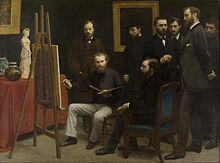
Henri Fantin-Latour, 1870

Paul Cézanne, c. 1873-1874
- At the Nouvelle Athènes, as at Guerbois, Manet was the dominating personality. In 1870 Fantin-Latour painted a famous group of some of the faithfuls of the Café Guerbois gathered about Manet who sits before his easel. In this picture, the impression is decidedly that of a master surrounded by his pupils. Cézanne alone continued to express his distrust of the extraordinary facility manifested by the painter of the Olympia. "A good job, though," he would say, in speaking of this canvas which... he tried to match with a new Olympia, more modern in treatment. Manet was equally hostile... as evidenced by his remark to Guillemet about Cézanne: "How can you abide such a foul painting [as An Afternoon at Naples]?"
I have asked some of the surviving painters of this period how Manet, who copied the Spaniards, and later abandoned his magnificent blacks to follow the wake of Monet and Impressionism, could have been hailed as the leader of a school. "Because," they would reply, "procedure counts for little in art. What made Manet a veritable prophet in his day, was that he brought a simple formula to a period in which the official art was merely fustian and conventionality. ..."- Ambroise Vollard, Paul Cézanne (1914) Paris, Éditions G. Crès; as translated by Harold L. Van Doren in Paul Cézanne: His Life and Art (1923, 1926) pp. 48-49.
- When our artists give us Venuses, they correct nature, they lie. Manet asked himself why lie, why not tell the truth; he introduced us Olympia, this fille of our time, whom you meet on the sidewalks.
- Emile Zola (1863) as cited in Jennifer Higgie, "Under the Influence - How the art of the past informs that of the present", Frieze, Oct. 1, 2013.
- Our fathers mocked Courbet, and now we go into ecstasies before him. We mock Manet and it will be our children who go into ecstasies before his canvases.
- Emile Zola (1866) as cited in Jennifer Higgie, "Under the Influence - How the art of the past informs that of the present", Frieze, Oct. 1, 2013.
- Like a true Parisien, he [Manet] brings Paris to the country and is incapable of painting a landscape without including well-dressed men and women. He loses interest in nature once it no longer beras the mark of everyday life.
- Emile Zola (1868) as cited in The Annenberg Collection: Masterpieces of Impressionism and Post-impressionism, publish. Metropolitan Museum of Art, New York, 2009, p 60 - note 7
- this remark of Zola in 1868 is describing exactly the attitude of Manet towards rural Nature and towards the developing modern city-life in Paris
- ..that the soldiers shooting Maximilian were wearing a uniform almost identical to that of our own troops. Fanciful artists give the Mexicans costumes from comic opera. M. Manet, who truly loves truth, has drawn [in his painting 'The Execution of Emperor Maximilian' their real costumes, which closely resemble those of the [[w:Vincennes|Vincennes'] infantrymen. You can understand the horror and anger of the gentlemen censors. What now! An artist dared to put before their eyes the cruel irony: France shooting Maximilian!
- Emile Zola, c. 1870; as cited by John Elderfield, in Manet and the Execution of Maximilian; New York: The Museum of Modern Art Publishers, 2006, p. 117
- political sensitivities then made it impossible for Manet to exhibit his paintings in France during the reign of Napoleon III - Wikipedia



